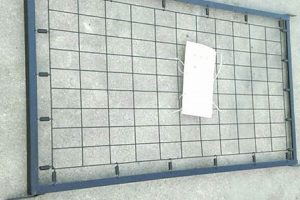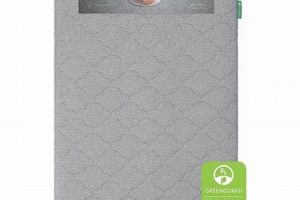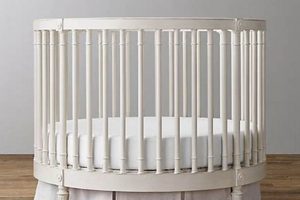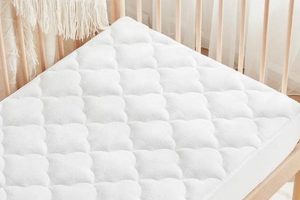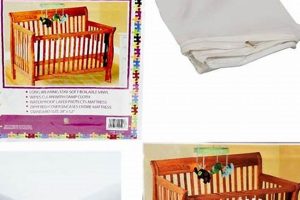The foundational structure beneath a crib mattress plays a critical role in infant safety and sleep quality. This component, typically constructed from metal or wood, provides a firm, stable, and level plane upon which the mattress rests. If this structure becomes damaged, warped, or otherwise compromised, it may necessitate repair or complete exchange to maintain a secure sleeping environment. For instance, a bent support bar could lead to uneven weight distribution, creating a potential hazard.
The integrity of this foundational element is essential for several reasons. A robust and properly functioning support system ensures the mattress remains flat, preventing gaps between the mattress and crib sides where entrapment could occur. Moreover, it contributes to the overall firmness of the sleep surface, which is vital for reducing the risk of Sudden Infant Death Syndrome (SIDS). Historically, inadequacies in crib design and construction have been linked to infant injuries and fatalities, highlighting the ongoing importance of stringent safety standards and proactive maintenance.
The following sections will delve into the common causes of damage to these components, methods for assessing their condition, guidelines for selecting appropriate replacements, and detailed instructions for performing the necessary exchange. The goal is to equip caregivers with the knowledge to ensure the continued safety and well-being of their infants.
Guidance on Crib Mattress Support Integrity
Maintaining a secure and stable sleep environment for infants is paramount. The following guidance addresses key considerations regarding the condition of the component beneath a crib mattress.
Tip 1: Regular Inspection: Routinely examine the structure for signs of damage, such as cracks, bends, or loose hardware. Early detection can prevent further deterioration and potential hazards.
Tip 2: Weight Limit Adherence: Observe the manufacturer’s specified weight limit for the crib and mattress. Exceeding these limits can stress the support and lead to premature failure.
Tip 3: Mattress Compatibility: Ensure the mattress is the correct size and type for the crib. Mismatched components can place undue strain on the support structure.
Tip 4: Hardware Tightening: Periodically tighten all bolts, screws, and connecting hardware. Loose fasteners can compromise the stability of the entire assembly.
Tip 5: Environmental Considerations: Avoid exposing the crib to excessive moisture or extreme temperature fluctuations. These conditions can weaken materials and accelerate corrosion.
Tip 6: Addressing Sagging: If sagging or unevenness is detected, address it immediately. This may indicate a failing support component requiring attention.
Tip 7: Professional Assessment: When in doubt, consult a qualified professional to assess the structural integrity of the crib and its underlying support system.
Adhering to these guidelines helps ensure the prolonged safety and functionality of the crib, providing a secure environment for infant rest.
The subsequent section provides information on component exchange procedures should a problem be identified.
1. Material Durability
Material durability is a foundational consideration in the context of crib mattress support. The lifespan and performance of the support structure are directly contingent upon the resilience of the materials from which it is constructed. For example, a support system constructed from low-grade steel is susceptible to bending or fracturing under consistent weight or stress, necessitating premature exchange. Conversely, a support fabricated from high-strength alloys or solid hardwoods offers greater resistance to deformation and prolonged utility. The choice of material, therefore, directly impacts the frequency and necessity of the component change process.
The selection of durable materials mitigates the risks associated with structural failure. A compromised support structure can create uneven surfaces, leading to infant discomfort and potential safety hazards. Consider a scenario where a crib mattress support, originally manufactured from particleboard, deteriorates due to humidity. This can result in sagging, creating a hazardous gap between the mattress and the crib frame. Replacement with a sturdier material, such as kiln-dried hardwood, is therefore crucial to maintaining a safe and stable sleep environment. The long-term cost-effectiveness of opting for durable materials often outweighs the initial expense due to reduced change frequency.
In summation, material durability is inextricably linked to the need for crib mattress support component change. Understanding the properties of different materials allows caregivers to make informed decisions regarding crib selection and maintenance. This proactive approach minimizes the likelihood of structural failure, ensuring the ongoing safety and well-being of the infant. While routine inspections and proper care are essential, the inherent durability of the support system material serves as the primary defense against premature component exchange.
2. Structural Integrity
The capacity of a crib mattress support to withstand applied forces without deformation or failure is paramount. Structural integrity directly influences the safety and stability of the sleep environment, dictating the necessity for support component exchanges when compromised.
- Load-Bearing Capacity Decline
A reduction in the support’s ability to bear the weight of the mattress and infant indicates compromised structural integrity. This decline can manifest as sagging, bending, or cracking. An example includes a metal support frame with weakened welds that gradually buckle under the weight, creating an uneven sleeping surface. This necessitates replacement to ensure uniform weight distribution and prevent potential hazards.
- Material Fatigue and Degradation
Repeated stress or environmental factors can lead to material fatigue, diminishing the support’s structural integrity. Wood supports, for instance, may experience rot or warping due to prolonged exposure to humidity. Similarly, metal components can corrode over time. This degradation compromises the support’s ability to maintain a level and stable surface, warranting a component exchange.
- Joint Instability
The points where individual support components connect are critical to overall structural integrity. Loose or weakened joints can compromise the stability of the entire assembly. An example is a crib with a support frame that utilizes screws to connect the side rails to the central support. If these screws become stripped or the wood becomes weakened, the joints become unstable, leading to swaying or tilting. Replacement or reinforcement of these joints is required to restore structural integrity.
- Impact Damage
Sudden impacts can inflict localized damage, compromising the structural integrity of the support. Dropping a heavy object onto the support or forcefully disassembling the crib can result in bending, cracking, or fracturing of individual components. Such damage necessitates a thorough inspection and potential component exchange to ensure the support can adequately bear the load without collapsing.
In conclusion, the structural integrity of a crib mattress support is a dynamic attribute that can be affected by various factors. Monitoring for signs of decline and promptly addressing any issues through component changes is critical to maintaining a safe and stable sleeping environment for infants. The implications of compromised structural integrity extend beyond mere inconvenience, posing potential risks to infant safety and well-being.
3. Proper Fasteners
The integrity of a crib mattress support system is intrinsically linked to the selection and application of appropriate fasteners. These components, often overlooked, are critical to maintaining the structural stability and load-bearing capacity of the support. Failure to employ suitable fasteners can compromise the entire assembly, potentially leading to premature deterioration or complete failure of the support structure, thus increasing the likelihood of a component change.
- Thread Engagement and Holding Strength
Adequate thread engagement is paramount for ensuring fasteners possess sufficient holding strength. Using screws that are too short for the material thickness can result in inadequate thread engagement, leading to stripping or loosening under load. For instance, if a wooden crib frame requires a support structure change, employing screws that only penetrate a shallow depth into the wood will compromise the joint’s ability to withstand the weight of the mattress and infant. This necessitates the use of longer screws or alternative fastening methods that provide greater holding strength.
- Material Compatibility and Corrosion Resistance
The material composition of fasteners must be compatible with the materials they are joining to prevent galvanic corrosion. Using steel screws with aluminum support components, for example, can initiate a corrosive process that weakens the fasteners and the surrounding material. This corrosion can lead to premature failure of the support structure, requiring its exchange. Stainless steel or coated fasteners are often preferred in environments where moisture or humidity is a concern.
- Appropriate Head Style and Torque Application
Selecting the correct head style for fasteners ensures proper load distribution and prevents damage to the surrounding material. Countersunk screws, for example, are suitable for applications where a flush surface is required, while pan head screws provide a larger bearing surface. Applying excessive torque during installation can strip threads or damage the fastener head, while insufficient torque can result in loosening over time. Both scenarios compromise the integrity of the joint and may necessitate replacement of the support component.
- Locking Mechanisms and Vibration Resistance
In applications subject to vibration, such as cribs that are frequently moved or rocked, fasteners with locking mechanisms are crucial for preventing loosening. Lock washers, nylon insert lock nuts, or thread-locking compounds can provide additional resistance to vibration-induced loosening. Without these measures, fasteners may gradually loosen, compromising the stability of the support structure and potentially leading to catastrophic failure. This makes crib mattress support replacement paramount.
In summary, the selection and proper application of appropriate fasteners are integral to the long-term stability and safety of a crib mattress support system. The interplay between thread engagement, material compatibility, head style, torque application, and locking mechanisms directly impacts the longevity of the support structure and, consequently, the frequency with which component changes may be required. A diligent approach to fastener selection and installation minimizes the risk of structural failure and ensures a safe sleeping environment for infants.
4. Accurate Measurement
The necessity for precise dimensional assessment is paramount when undertaking the exchange of a crib mattress support. Incorrect measurements can lead to the acquisition of an incompatible component, rendering it unusable and potentially compromising the structural integrity of the crib. The connection between accurate measurement and the successful execution of a support change is direct and consequential. For instance, if the internal width of the crib is imprecisely measured, a replacement support that is either too wide or too narrow will fail to fit securely. A support that is too wide may exert undue stress on the crib frame, while one that is too narrow may create hazardous gaps. In either scenario, infant safety is jeopardized, underscoring the critical role of accurate measurement as a prerequisite for a safe and effective support exchange.
Practical applications of accurate measurement extend beyond simple width and length determinations. The depth of the support structure, the placement of mounting hardware, and the angles of connecting elements must all be meticulously measured to ensure compatibility with the existing crib frame. Furthermore, accurate measurements are essential for ensuring compliance with relevant safety standards. Regulations often specify minimum dimensions for support components to prevent mattress sagging or other hazards. Failure to adhere to these standards, due to measurement errors, can result in non-compliance and potential legal ramifications. Therefore, the ability to obtain and interpret precise measurements is a fundamental skill for anyone involved in the exchange of a crib mattress support.
In summary, accurate measurement is not merely a preliminary step in the crib mattress support exchange process; it is an indispensable element that directly impacts the safety and efficacy of the entire procedure. Challenges associated with inaccurate measurement include the acquisition of incompatible components, compromised structural integrity, and potential non-compliance with safety standards. Emphasizing the importance of precise dimensional assessment is therefore crucial to safeguarding infant well-being and mitigating the risks associated with improper support component changes.
5. Compliance Standards
Adherence to established compliance standards is crucial in the context of crib mattress support changes. These standards, often mandated by regulatory bodies, aim to ensure the safety and structural integrity of cribs, minimizing risks to infants. Failure to comply with these standards during the exchange of a support component can have severe consequences, ranging from product recalls to potential injuries.
- Mandatory Testing and Certification
Many jurisdictions require cribs and their components, including mattress supports, to undergo rigorous testing and certification processes. These tests evaluate factors such as load-bearing capacity, material strength, and the presence of hazardous substances. Replacement supports must possess the appropriate certifications to demonstrate compliance with these standards. For instance, a replacement support lacking a valid certification mark may indicate that it has not been subjected to the necessary safety evaluations, increasing the risk of structural failure or exposure to harmful chemicals.
- Dimensional Requirements and Tolerances
Compliance standards often specify precise dimensional requirements for crib mattress supports to ensure a secure and proper fit within the crib frame. These standards define the allowable tolerances for length, width, and thickness, minimizing the risk of gaps or instability. Replacing a support with one that deviates from these specified dimensions can create hazardous conditions. For example, a support that is too narrow may allow the mattress to shift, creating a gap between the mattress and the crib sides, where an infant could become entrapped.
- Material Safety and Composition
Standards dictate acceptable materials for crib mattress supports, restricting the use of substances that may pose a health risk to infants. These restrictions often target materials containing lead, phthalates, or other potentially harmful chemicals. When exchanging a support, it is imperative to ensure that the replacement is constructed from compliant materials. For instance, a support made from recycled plastic that contains prohibited substances may release harmful vapors, posing a health risk to the infant.
- Labeling and Traceability Requirements
Compliance standards typically mandate that crib mattress supports be clearly labeled with relevant information, including the manufacturer’s name, model number, date of manufacture, and compliance certifications. This labeling enables traceability and facilitates product recalls in the event of safety concerns. A replacement support lacking proper labeling may indicate a lack of adherence to compliance standards, raising concerns about its safety and origin.
In conclusion, adherence to compliance standards is non-negotiable when dealing with crib mattress support replacement. The facets outlined above highlight the importance of selecting replacement supports that meet or exceed established safety requirements. Proactive attention to compliance standards minimizes the risk of harm and ensures a safe sleeping environment for infants.
6. Installation Precision
The accurate and meticulous fitting of a crib mattress support is a non-negotiable prerequisite for infant safety. The term “installation precision” encapsulates the critical processes and considerations involved in ensuring a replacement support is properly and securely integrated into the crib structure. Deficiencies in installation can negate the inherent safety features of even the most robust support, leading to potentially hazardous conditions. The following explores key facets of installation precision and their direct bearing on the suitability and safety of a changed support.
- Hardware Alignment and Tightening
Correct alignment of mounting hardware is essential for ensuring uniform stress distribution across the support structure. Misaligned hardware can induce localized stress concentrations, predisposing the support to premature failure. Proper tightening of fasteners is equally critical; under-tightening can result in instability and loosening over time, while over-tightening can strip threads or damage the surrounding material. For instance, if the mounting brackets for a metal support are not precisely aligned with the pre-drilled holes in the crib frame, the resulting stress could cause the welds to fail prematurely. A calibrated torque wrench should be employed to ensure fasteners are tightened to the manufacturer’s specified torque, minimizing the risk of both under- and over-tightening.
- Gap Mitigation and Flush Seating
The presence of gaps between the support and the crib frame can compromise stability and create potential entrapment hazards. Installation precision dictates the need to eliminate any such gaps, ensuring the support is flush with the surrounding structure. Shimming may be necessary to compensate for minor dimensional variations or irregularities in the crib frame. If a wooden support is slightly narrower than the space it occupies, shims should be strategically placed to fill the gap and prevent movement. Failure to address even small gaps can allow the mattress to shift, creating a space between the mattress and crib sides where an infant could become lodged.
- Leveling and Weight Distribution
A level support surface is crucial for ensuring uniform weight distribution and preventing mattress sagging. Installation precision demands the use of a leveling device to confirm the support is perfectly horizontal. If the crib frame is not perfectly level, shimming may be required to compensate for any unevenness. An unlevel support can cause the mattress to tilt or sag, potentially increasing the risk of SIDS. Precise leveling ensures the infant’s weight is evenly distributed across the mattress, promoting a comfortable and safe sleep environment.
- Edge Securement and Anti-Rotation Measures
The securement of the support’s edges to the crib frame is essential for preventing lateral movement or rotation. Installation precision often involves the use of clips, brackets, or other fasteners to rigidly attach the support to the surrounding structure. For example, a metal support frame may be secured to the wooden crib frame using L-brackets and screws. These brackets prevent the support from shifting or rotating during use, maintaining its position and preventing hazardous gaps from forming. Insufficient edge securement can allow the support to slide or shift, particularly when the crib is subjected to movement or vibration, compromising the safety of the infant.
Collectively, these facets underscore that achieving installation precision is more than a mere assembly task; it is a fundamental safety measure. Any compromise in installation precision directly undermines the intended performance of the changed crib mattress support and elevates the risk of infant injury. Therefore, adhering to meticulous installation practices is a non-negotiable aspect of ensuring a secure and functional crib environment.
7. Safety Verification
The process of confirming the correct functionality and safety of a crib mattress support following its replacement is critical. Safety verification is not a mere formality but a necessary safeguard to ensure the infant’s well-being and prevent potential hazards.
- Load-Bearing Capacity ValidationThis facet involves assessing the replacement support’s ability to withstand the weight of the mattress and the infant. Visual inspection for sagging, bending, or instability is insufficient. Formal load testing, adhering to relevant standards, is required. For instance, a support rated for 50 pounds should be subjected to a static load exceeding this limit for a specified duration to verify its structural integrity. Failure to validate load-bearing capacity can result in support failure, creating an uneven or unsafe sleep surface.
- Gap Measurement and Entrapment PreventionProper safety verification includes meticulously measuring the gaps between the mattress and the crib frame following the change. These gaps must adhere to regulatory limits to prevent infant entrapment. Using calibrated measuring tools is necessary. An example includes verifying that the gap between the mattress edge and the crib side rail does not exceed two finger widths. Deviations from these limits necessitate immediate corrective action, such as selecting a different mattress or modifying the support structure.
- Hardware Security and Joint StabilityVerifying the security of all fasteners and the stability of joints is essential. Each bolt, screw, and connecting element must be thoroughly inspected to ensure proper tightening and alignment. A torque wrench should be used to verify that fasteners are tightened to the manufacturer’s specifications. Furthermore, joints should be subjected to moderate force to assess their stability. Loose or improperly secured hardware can compromise the support’s structural integrity, increasing the risk of collapse or instability.
- Compliance Documentation and CertificationSafety verification extends to confirming that the replacement support is accompanied by relevant compliance documentation and certifications. These documents provide evidence that the support meets established safety standards. Checking for certifications from recognized testing organizations is imperative. For instance, a support lacking a valid ASTM certification raises concerns about its safety and reliability. Absence of compliance documentation should prompt further investigation and potentially rejection of the component.
Collectively, these elements underscore the necessity of comprehensive safety verification subsequent to a crib mattress support change. A systematic and meticulous approach, incorporating these measures, minimizes the risk of overlooking potential hazards and ensures a secure sleep environment for infants. Safety verification is not a concluding step but an integral aspect of the entire support replacement process.
Frequently Asked Questions
The following addresses common inquiries pertaining to the support structure beneath a crib mattress, its maintenance, and exchange.
Question 1: What are the primary indicators that a crib mattress support requires replacement?
Sagging, visible damage (cracks, bends, fractures), loose joints, and deviations from original dimensions indicate the necessity for a component exchange. Auditory cues such as creaking or unusual noises under load are also indicative of potential compromise.
Question 2: Can a damaged crib mattress support be repaired instead of replaced?
Repairing a compromised support is generally discouraged. Modifications or repairs may not restore the original structural integrity and may introduce unforeseen hazards. Replacement with a compliant component is the recommended course of action.
Question 3: What type of replacement crib mattress support is recommended?
The replacement should be identical to the original component or a suitable substitute specified by the crib manufacturer. It must comply with current safety standards and possess the appropriate certifications. Deviation from these guidelines is not advised.
Question 4: Are there any safety standards related to crib mattress supports?
Yes. Standards such as those promulgated by ASTM International and regulatory bodies outline minimum requirements for crib construction, including support structures. Verification of compliance with these standards is essential during any component exchange.
Question 5: How should a replacement crib mattress support be installed to ensure safety?
Installation must adhere to the crib manufacturer’s instructions. Precise alignment, proper hardware tightening, and gap mitigation are crucial. Deviations from the prescribed installation procedure can compromise structural integrity and introduce safety hazards.
Question 6: What steps should be taken to verify the safety of a replaced crib mattress support?
Post-installation, the support’s load-bearing capacity, joint stability, and dimensional compliance should be verified. Gaps between the mattress and crib frame must be measured to ensure they adhere to regulatory limits. Absence of any of these parameters necessitates corrective action.
These inquiries and responses provide a foundational understanding of critical factors relating to crib mattress support replacement. Diligence in adherence to these guidelines is paramount for infant safety.
The next section will focus on the importance of material compliance.
In Closing
This exploration has underscored the critical role of maintaining the integrity of the foundational structure beneath a crib mattress. Key aspects such as material durability, structural integrity, proper fasteners, accurate measurement, compliance standards, installation precision, and thorough safety verification have been presented as essential considerations. A failure to address any of these facets during the process of crib mattress support replacement can have profound implications for infant safety.
The decision to exchange a compromised component should not be taken lightly. Prioritize adherence to established guidelines, meticulous execution, and diligent verification protocols. The well-being of infants depends on a steadfast commitment to maintaining a secure and stable sleep environment. Therefore, thoroughness and precision remain paramount when undertaking this critical task.


![Lullaby Earth Crib Mattress: Safe, Certified [Sleep] Organic & Natural Mattress Buyer’s Guide: Non-Toxic Sleep Solutions Lullaby Earth Crib Mattress: Safe, Certified [Sleep] | Organic & Natural Mattress Buyer’s Guide: Non-Toxic Sleep Solutions](https://mattressworldpa.com/wp-content/uploads/2025/07/th-1276-300x200.jpg)
